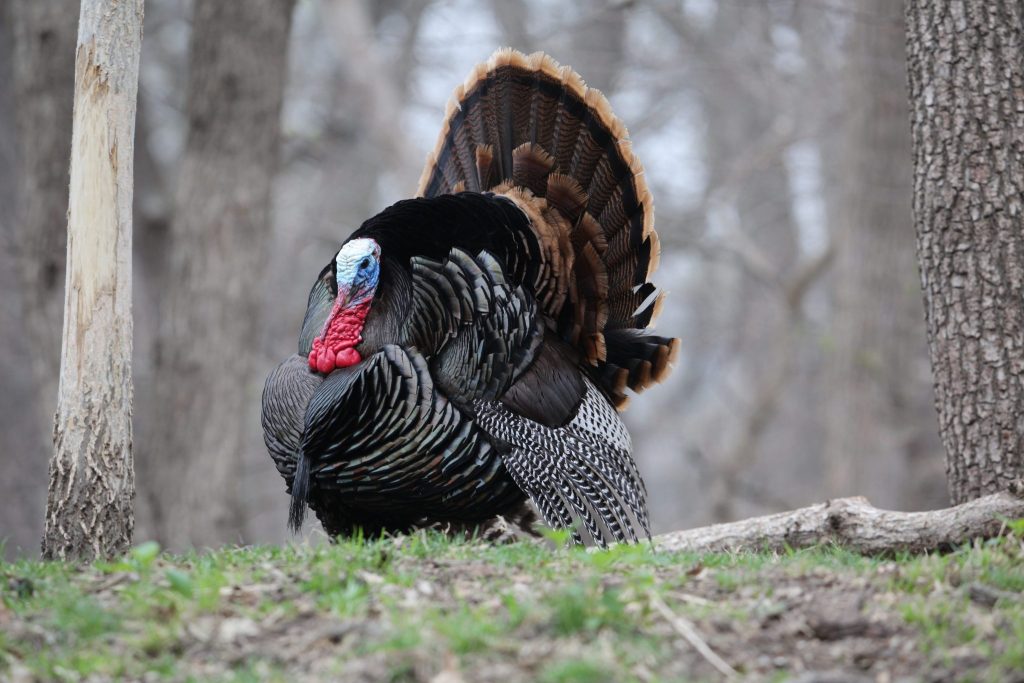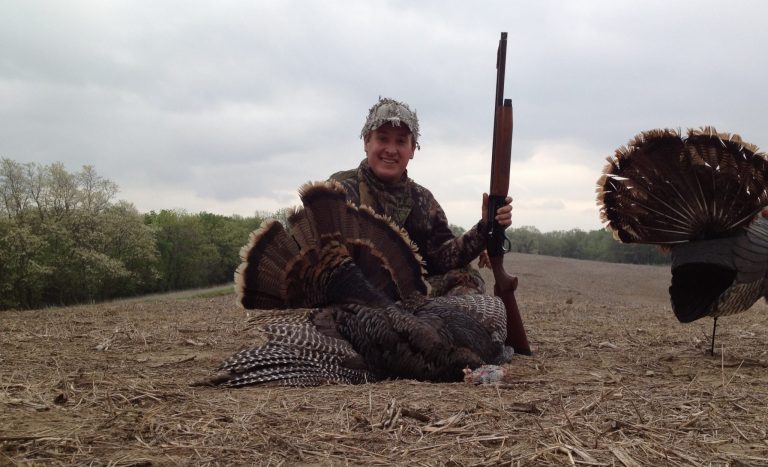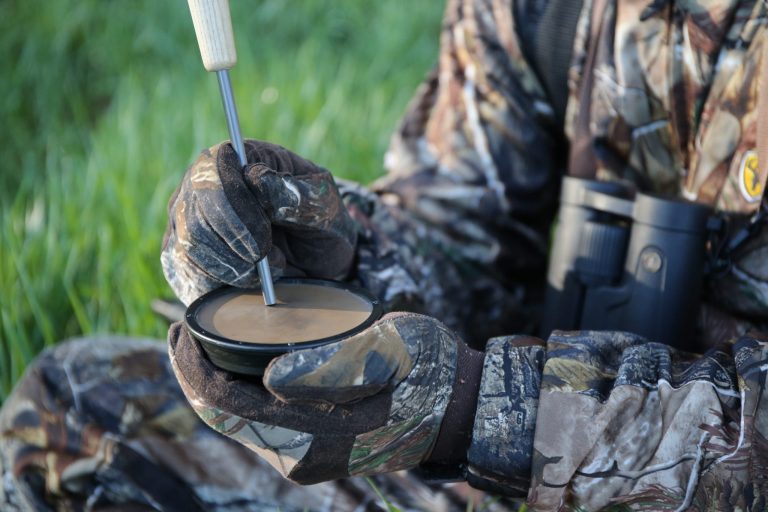
By Ryan Sparks
Dedicated turkey hunters dream of completing a “grand slam,” or killing a bird from each of the four subspecies of the North American turkey. To complete a grand slam, a hunter might travel from Alabama to Texas to South Dakota to Florida. As a teenager, while enjoying the developing turkey hunting in Nebraska, I dreamed about this turkey hunting adventure, but realized it would be a long time before I could roam the country in pursuit of turkeys. Instead, I devised a different challenge.
I was already obsessively hunting turkeys with a bow and conventional shotgun, but when I spotted a used muzzleloading shotgun for sale, I had an idea. I realized that with Nebraska’s three-bird limit I had the opportunity to hunt turkeys with a bow, muzzleloading shotgun, and conventional shotgun all in one season. I had no idea what an incredible experience it would be and how my adventures could help other hunters challenge themselves as well.
Bows and Beards
Bowhunting turkeys is more difficult than hunting them with a shotgun for two reasons. First, archery equipment limits a hunter’s shooting range. Second, and most importantly, a bow must be drawn before shooting. A turkey’s excellent eyesight is its principal defense. They can see almost as well as a hawk and don’t have to shift their focus to see objects at different distances clearly. Everything within their field of view is always in focus. With such a good sense of sight they can notice the slightest motion.
To hide the movement of drawing, archery hunters use natural blinds constructed of branches, brush, and grass or manufactured “pop-up” blinds – so named because they unfold and set up quickly. At the time, I used a pop-up blind for its convenience, but I now enjoy making impromptu natural blinds and trying to draw when the bird is looking the other direction.
The other major difference between archery and shotgun hunting is that archery season opens earlier, when birds are less aggressive and sometimes grouped in large flocks. As males become more aggressive, they will part ways, and flocks become smaller. This makes calling more effective later in the season because it’s easier to call in a single turkey than an entire flock.
When turkeys are grouped together, it’s a better strategy to make soft calls to entice hens or set up along known travel routes. As with all hunting, no two situations are the same, but it’s a good idea to start slow and soft and gradually increase the volume and aggression of your calling.
To prepare for my opening morning of archery season, I hiked up a grassy fence line to the top of a hill that overlooked a field where I had seen turkeys feeding the previous week. As the sun inched downward, a group of birds made their way into the field. One by one they took flight and roosted in a group of cottonwood trees for the night. I knew the next morning they would glide down the opposite side of the creek and begin their day in the field below.
Well before sunrise, I stood atop the same hill and listened as several hens yelped from their roost and two toms responded with thunderous gobbles. Under the cover of darkness, I was able to sneak within 100 yards of where the birds were roosted. However, it was dead still, and I was nervous they would hear me setting up the blind. I was glad I left plenty of time before sunrise, because it took nearly an hour to get in position, place my decoys, and unfold the blind without creating too much noise. Thankfully, the turkeys continued calling, and their vocalizations helped to cover any noise I made.
As the first glow of sunlight dimly lit the field, I could barely make out the turkeys in their roost. When I was confident there was enough light for them to see my decoys, I made several soft yelps on a slate call to get their attention. A hen responded loudly with a challenging tone, and one of the toms shifted on its branch to face me. I didn’t make another noise, and 10 minutes later the turkeys pitched off their roost and landed 200 yards to the east.
The hens scratched and pecked in the cut bean field, uninterested in my decoys, and the toms followed suit. As the group turned and began moving the other direction, I made several loud yelps and cuts. I knew this would either aggravate or frighten the group, but it was my last chance before they slipped away into the timber. The loud calling infuriated the lead hen, and she immediately turned and ran my direction.
The other turkeys watched from afar as she inspected my decoys, pecking them and trying to figure out who had been so insubordinate. Eventually, she began feeding again. The other birds sidled toward her. It seemed to take them a lifetime to reach me, and each step they took my heart beat faster.
One of the toms hesitantly hung back, but the other strutted on the heels of the last hen. When he was finally in range I took a deep breath, drew my bow, and took aim. The arrow struck home, and the tom turned and ran toward the timber, but he didn’t make it far before collapsing in the bean stubble. The first leg of my challenge was complete.
Stalk for Spurs
Hunting turkeys with a shotgun gives you more mobility than bowhunting. While bowhunting, you must conceal yourself with a blind, but shotgun hunting is more flexible as every tree offers a place to hide, and aiming involves a fraction of the movement compared to drawing a bow. This allows a shotgun hunter to move from place to place, calling to locate active birds and quickly setting up a decoy when they respond. Also, you can sometimes stalk within range of birds by using the terrain to hide your movement. This style of turkey hunting is called “run and gun,” and it’s my favorite way to hunt turkeys.

The first week of my shotgun season left me scratching my head. I wasn’t having any problems finding birds, but I couldn’t lure the toms away from their hens. When hens are receptive to a tom’s attention, it’s hard to compete with the real thing. I had thought getting a turkey with a regular shotgun was going to be the easiest part of this challenge, but the birds were proving otherwise. I tried every strategy I could think of – locating a roost and setting up near it in the morning, actively calling and moving quickly to cover lots of ground and setting up on travel corridors waiting for birds to pass by. Nothing worked.
Midway through the second week of shotgun season a thick fog settled in as I was walking back to the truck after another unsuccessful morning. I was hiking along the bottom of a steep field edge when I saw three dark shapes walking along the top of the hill 100 yards in front of me. Using my binoculars, I could just make out the three jakes through the fog. They were in the middle of a wide-open field, in a hurry, and were moving toward the neighbor’s fence line. I didn’t have time to set up, so I moved as quickly as I could, using the steep hillside to block my movement from their view.
During my dash, I lost sight of the birds but guessed they would be approaching the fence soon. There were two steep terraces between me and the top of the hill, and I crawled toward the upper one with a strutting tom decoy in hand. As I reached the top of the rise, I raised the decoy and made several soft purrs with my mouth call. I slowly lifted my head to look, but before I could see over the terrace I heard fast crunching footsteps, and the decoy exploded from my hand. When the jakes saw the decoy, they charged in prepared for a fight. Their strength in numbers must have given them courage, and the lead jake spurred the decoy while I was trying to stay out of sight. Fueled on adrenaline, I stood and shot the closest bird where he stood. As the other two ran away in confusion, I sat down to collect myself. It was one of the most memorable hunts of my life.
Struts and Smoke
Having never hunted with a muzzleloader, I practiced extensively before the season. After patterning the shotgun with a variety of shot sizes and powder loads, I reached a combination where I was comfortable, but the shot would have to be 25 yards or less. I was excited to try muzzleloader hunting, because it would allow the same mobility of conventional shotgun hunting with the added challenge of limiting my range. This decreased range meant I was going to have to get a tom to commit to the decoys and not hang up in the distance.

After a long day of spotting turkeys, gauging their direction of travel, and trying to figure out how to snake along a creek or follow a finger of trees to reach them, I had yet to get in front of one. However, I had watched two separate toms use the same fence crossing. I decided to settle in and spend the rest of the afternoon within shooting distance of the crossing. There were two gnarly cedar trees to the west. Using hand pruners and a folding saw I created an opening at the base of the tree and stuck the cut branches in the ground in front of me. After creating my hide, I placed a hen decoy 15 yards to the left of me facing away. I did the same with a strutting tom decoy at 10 yards but turned him facing toward me. Toms often approach hens from behind and other males from the front. Setting my decoys like this would shorten the distance between myself and an approaching tom by making him pass between me and the decoys.
I spent the next hour making occasional yelps with no response. It had been a long day, and with the lack of action I was beginning to nod off when I heard the unmistakable spit of a tom behind me. For those unacquainted with this term, a tom will sometimes make a “pfft” sound when it is excited or angry. It almost sounds like a muffled sneeze. Unlike a gobble which can be heard from a long distance, if you hear a spit it means a turkey is close by and fired up. I suspected a tom had snuck in behind me, so I shouldered my gun, waiting for it to appear. Ten minutes went by and I hadn’t heard anything more, so I slowly turned and peered through the tree, but couldn’t make anything out.
Bridging my shotgun between my shoulder and knee to free up my hands, I used a slate call to make a few gentle purrs and whines. These soft calls often bring a bird the last few critical yards. From the corner of my eye, I was surprised to see the turkey approaching from the right instead of the fence crossing to my left. He ducked between two strands of barbed wire and accelerated his approach until he was just out of range. Slowing, he went into a strut and moved toward the tom decoy. At this point he was only 10 yards in front of me and looking my direction. When he turned to look at the hen, I aimed at the base of his head and pulled the trigger. A billow of smoke erupted from the gun and I couldn’t see what happened. Then I heard the sound of wings beating the ground and raced to my feet. As the smoke settled, I knelt over the bird, having harvested three birds with three different weapons in one season.
The Good Old Days
This challenge made me realize how good the turkey hunting was in Nebraska. I had so much fun I made it a tradition and was able to accomplish the feat every year from 2007-2012 until I moved to attend graduate school. Two of the years I even switched out my compound bow for a recurve with the same success.
Looking back, I couldn’t have been luckier. I had no idea that Nebraska was quickly developing the best turkey hunting in North America. It led to a passion that continues today and taught me what it takes to be a successful turkey hunter. More importantly, it made me appreciate the amazing hunting in my home state.
Since those days, turkey hunting has only gotten better. The turkey population has exploded over the last decade, and now Nebraska has the reputation of being a turkey hunting destination and welcomes hunters from around the world. With hunting opportunities in every county, nearly 1 million acres of public access, three permits available for the spring season and two in the fall, it’s easy to understand why. Making things even sweeter, Nebraska’s spring season is one of the longest in the country, so there is plenty of time to challenge yourself as well.
